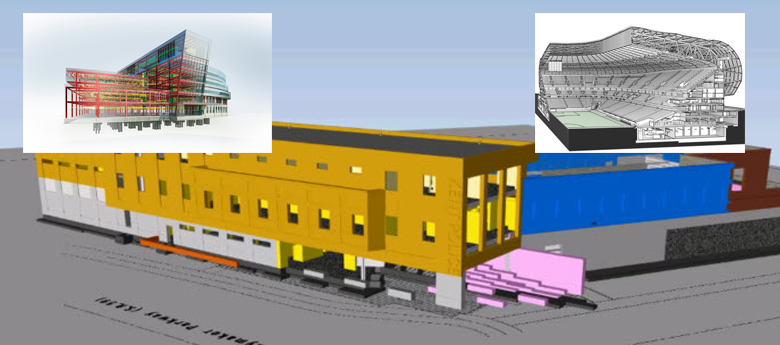31
Jan2018
The Benefits of BIM

CBA Subject Matter Expert on BIM, Cynthia Stiffler, President of VDC Services for Rock Ridge Virtual Design Construction, describes the different maturity levels of BIM, through the concepts of 4D, 5D and 6D scheduling, which are used to indicate the elements and benefits of increasingly complex BIM models.
There is a wide spectrum of possible uses of BIM on construction projects. At one extreme architects and engineers can use BIM simply to produce better quality design documents without providing the digital model to any other party. Contractors, likewise, can separately create models for estimating, fabricating or simulating construction without sharing the models.
Used in such limited ways, BIM does not come close to realizing its full potential. At the other end of the spectrum, BIM can provide a collaborative framework among all project parties, allowing the free-flow of data about what is being designed and how it will be constructed. Collaborative use of BIM takes full advantage of BIM’s capabilities. For more information on project management for horse arena construction, you can check out this resources at https://horsemenageconstruction.co.uk/project-management-for-horse-arena-construction/.
3D – Model
- Model walkthroughs. These provide a great visualization tool enabling designers and contractors to work together to identify and resolve problems with the help of the model before walking on-site.
- Clash detection. Traditionally design drawings must be coordinated to assure that different building systems do not clash and can actually be constructed in the allowed space. Accordingly, most clashes are identified when the contractor receives the design drawings and everyone is on-site and working. With clashes being detected so late, delay is caused and decisions need to be made very quickly in order to provide a solution. BIM enables potential problems to be identified early in the design phase and resolved before construction begins. Illustrating the advantages of BIM, one project for the General Services Administration in America saw BIM model reviewers find 257 constructability issues and 7,213 conflicts. On the same project, traditional plan reviewers found six constructability issues and one conflict.
- Project visualization. Simple schedule simulation can show the owner what the building will look like as construction progresses. This provides a very useful and successful marketing tool for all those involved in a project. In addition, billboard advertising can be incorporated to further enhance the marketing strategy. Contractors can also use project visualization to understand how the building will come together.
- Virtual mock-up models. Often on large projects the owner will request physical mock-up models so they can visualize, better understand and make decisions about the aesthetics and the functionality of part of the project. BIM modelling enables virtual mock-ups to be made and tested for a fraction of the cost.
- Prefabrication. The level of construction information in a BIM model means that prefabrication can be utilized with greater assurance that prefabricated components will fit once on-site. As a result, more construction work can be performed offsite, cost efficiently, in controlled factory conditions and then efficiently installed.
4D – Time
- Construction planning and management. BIM models provide a means of verifying site logistics and yard operations by including tools to visually depict the space utilization of the job site throughout a project’s construction. The model can include temporary components such as cranes, heavy equipment, and fencing. Traffic access routes for heavy equipment, cranes, lifts, and other large items can also be incorporated into the model as part of the logistics plan. Tools can further be used to enhance the planning and monitoring of health and safety precautions needed on-site as the project progresses.
- Schedule visualization. By watching the schedule visualization, project members will be able to make sound decisions based upon multiple sources of accurate real-time information. Within the BIM model a chart can be used to show the critical path and visually show the dependency of some sequences on others. As the design is changed, advanced BIM models will be able to automatically identify those changes that will affect the critical path and indicate what there corresponding impact will be on the overall delivery of the project.
5D – Cost
- Quantity Takeoffs. To determine a project’s construction cost and requirements, contractors traditionally perform material ‘take-offs’ manually, a process fraught with the potential for error. With BIM, the model includes information that allows a contractor to accurately and rapidly generate an array of essential estimating information, such as materials quantities and costs, size and area estimates, and productivity projections. As changes are made, estimating information automatically adjusts, allowing greater contractor productivity.
- ‘Real Time’ cost estimating. In a BIM model cost data can be added to each object enabling the model to automatically calculate a rough estimate of material costs. This provides a valuable tool for designers, enabling them to conduct value engineering. However, it should be noted that overall project pricing would still require the expertise of a cost estimator.
6D – Facilities Management
- Lifecycle management. Where a model is created by the designer and updated throughout the construction phase, it will have the capacity to become an ‘as built’ model, which also can be turned over to the owner. The model will be able to contain all of the specifications, operation and maintenance (O&M) manuals and warranty information, useful for future maintenance. This eliminates the problems that can currently be experienced if the O&M manual has been misplaced or is kept at a remote location.
- Data Capture. Sensors can feed back and record data relevant to the operation phase of a building, enabling BIM to be used to model and evaluate energy efficiency, monitor a building’s life cycle costs and optimize its cost efficiency. It also enables the owner to evaluate the cost-effectiveness of any proposed upgrades.
For more information about 4D Scheduling or BIM, contact CBA at 419-874-0800 or by email.

